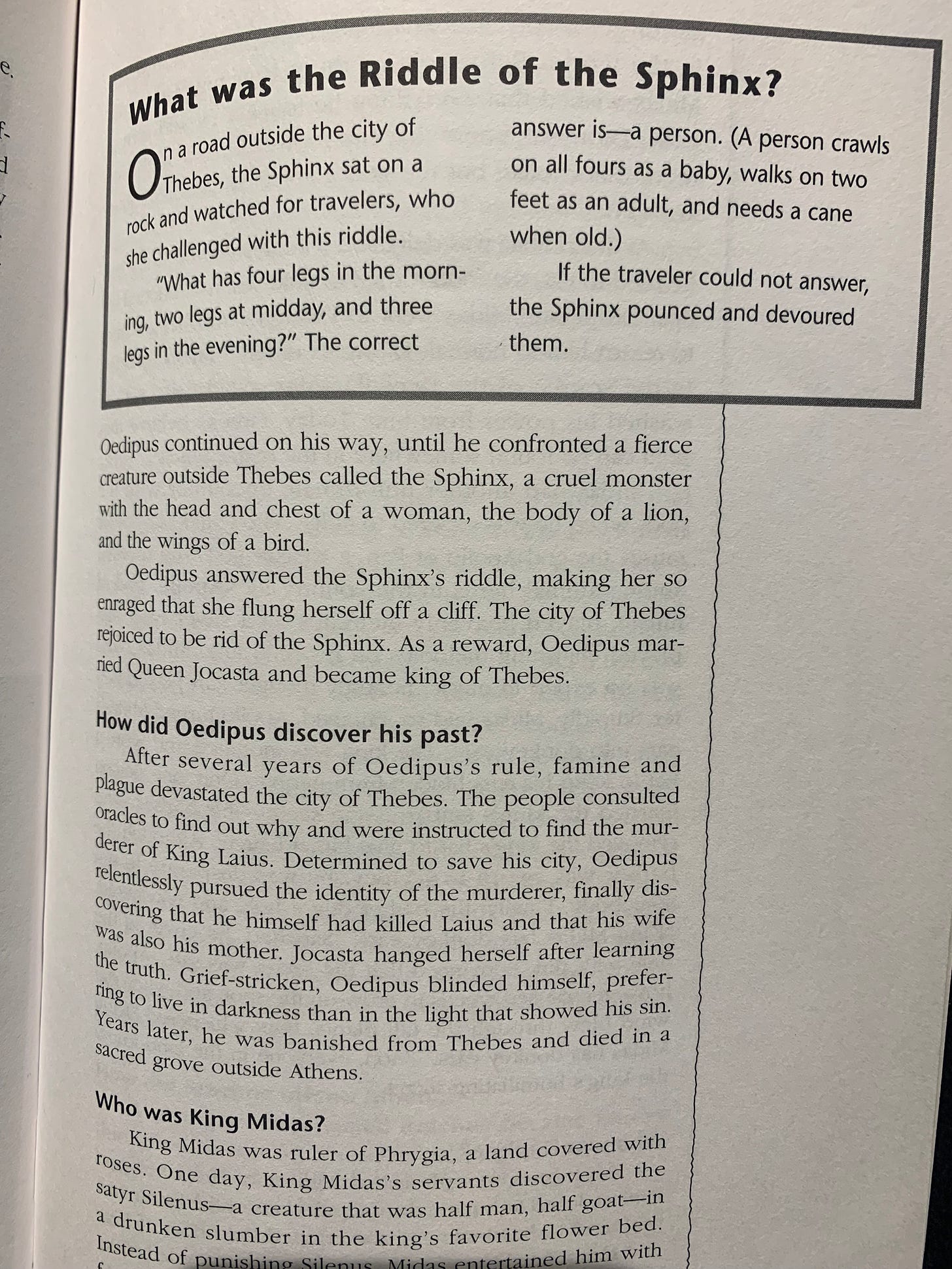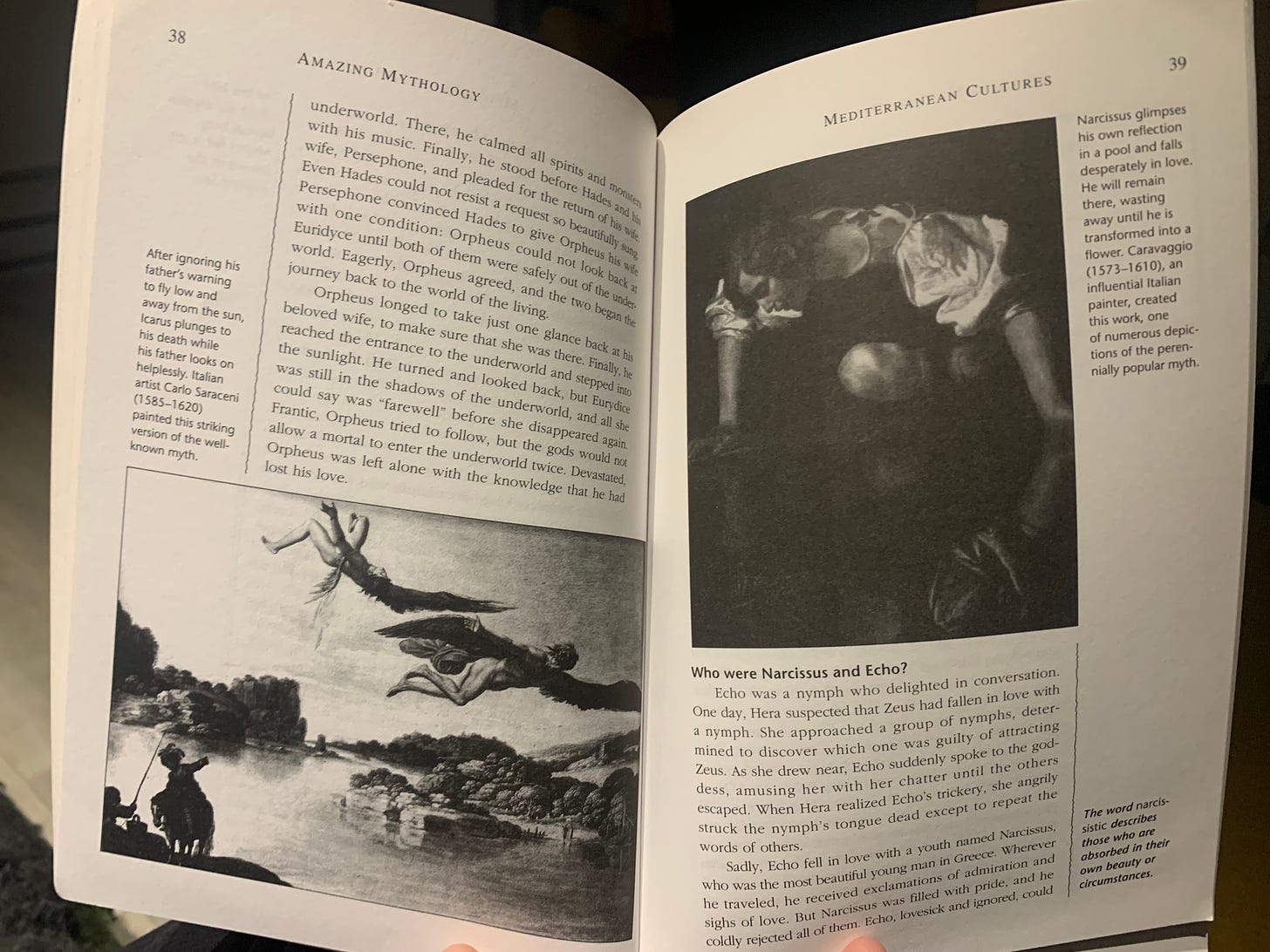I’ll be blunt: Amazing Mythology isn’t a visually striking book. It’s a modest, well-meaning little paperback, illustrated with black-and-white images of historical artwork. Its language is simple, explaining the basic tenets of world myth and legend to a young audience.
But when I was about seven years old, I didn’t need striking visuals or lavish prose. I devoured Amazing Mythology from cover to cover and back again, even the sections on Norse and Aztec myths that frightened me (I was a delicate child, easily spooked). I read the Greek myth section over and over again, memorizing not just the names of all the gods and heroes, but their traits, their symbols, every piece of trivia I could find.
To this day, my mum loves telling a story about this book. She got it for me from the public library, because I already owned and adored a copy of the perennial D’Aulaires’ Book of Greek Myths and hungered for more stories. When the time came to return Amazing Mythology to the library, I promptly burst into tears!
It was only a matter of time before I gifted my own copy ofAmazing Mythology. I still have it; it sits proudly on my designated mythology shelf, alongside other beloved childhood classics. Rosemary Sutcliff, Christina Balit, Roger Lancelyn Green, the ever-wonderful D’Aulaires. (I will have to write about all of these eventually…)
Looking at Amazing Mythology now, I’m moved by how earnestly informative it is. The little sidebars and trivia boxes feel less like a storybook and more like something designed for a classroom. The black-and-white images all come with captions that tell you about artists. The back cover even gives you a list of prompts and tells you what pages of the book to turn to if any of them catch your eye.
I also appreciate the strong emphasis that this is a Public Library Book, capitalization and all. I also appreciate Amazing Mythology’s attempts at a global survey of mythology; some of the wording and language in a few sections is dated after nearly 25 years, but the tone is overall fairly respectful. It’s interesting how much has changed about the way we approach global storytelling in my (brief!) lifetime. We’re moving away from the days of a single author retelling stories from all over the world, and lumping all the Indigenous cultures of the Americas into a single chapter, while dedicating multiple chapters to mythology in Europe.
There’s plenty of existing scholarship around introducing myth and history to children, and around children’s media as a form of ancient Mediterranean reception. While children’s myth books are, of course, pieces of historical reception, Amazing Mythology adds another interesting layer to the modern exploration of ancient stories. It doesn’t feature original illustrations the way many other myth books do; instead, it’s full of black-and-white photos of historical art that depicts mythology. Each pictures comes with a caption, inviting young readers to learn more about art history. This encourages curious kids to go and look up historical painters and sculptors on their own time, but it also subtly plants the concept of reception in their minds. Some of these pictures are of ancient artwork, but most of them are paintings from the Renaissance and drawings from the Golden Age of Illustration. This teaches kids that people have been interested in ancient mythology for centuries, while introducing them to some important and memorable artists. In fact, Amazing Mythology may have been my first brush with the work of Arthur Rackham, who remains one of my favorite illustrators to this day.
These days, I’m very interested in first introductions to ancient Mediterranean myth. I have many more books from my childhood that I’d like to discuss here on A Reception Collection, and I love comparing my own early forays into these stories with the forays of others. If you have a memory or an introductory piece of media you’d like to share, please reach out and tell it to me! I wonder if Amazing Mythology impacted anyone else’s life as strongly as it impacted mine.








A clarification: we renewed that book as many times as we could before finally returning it. So your tears were forestalled a few times before the painful separation!
ahh, rackham! <3
my first was a spiral-bound myth collection from my childhood homeschooling curriculum. the illustrations were black and white, so i colored them in. later i did the same with padraic colum's children's homer.